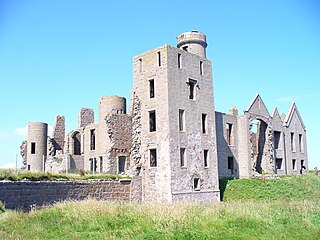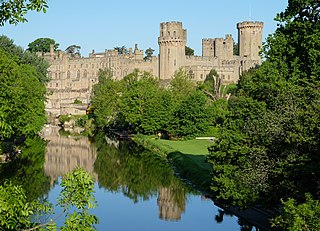
Warwick Castle is a medieval castle developed from a wooden fort, originally built by William the Conqueror in 1068. Warwick is the county town of Warwickshire, England, situated on a bend of the River Avon. The original wooden motte-and-bailey castle was rebuilt in stone in the 12th century. During the Hundred Years War, the facade opposite the town was refortified, resulting in one of the most recognisable examples of 14th-century military architecture. It was used as a stronghold until the early 17th century, when it was granted to Sir Fulke Greville by James I in 1604. Greville converted it to a country house and it was owned by the Greville family, who became Earls of Warwick in 1759, until 1978 when it was bought by the Tussauds Group.

Earl of Warwick is one of the most prestigious titles in the peerages of the United Kingdom. The title has been created four times in English history, and the name refers to Warwick Castle and the town of Warwick.
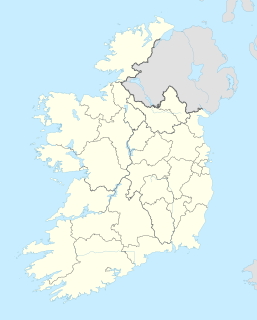
Croom is a village in County Limerick, Ireland. It is located just off the N20 on the River Maigue. It is 8 km southeast of Adare on the N20.

Powderham Castle is a fortified manor house situated within the parish and former manor of Powderham, within the former hundred of Exminster, Devon, about 6 miles (9.7 km) south of the city of Exeter and 1⁄4 mile (0.4 km) north-east of the village of Kenton, where the main public entrance gates are located. It is a Grade I listed building. The park and gardens are Grade II* listed in the National Register of Historic Parks and Gardens.

Clan Grant is a Highland Scottish clan.
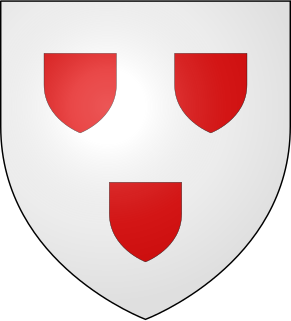
Clan Hay is a Scottish clan that has played an important part in the history and politics of Scotland. Members of the clan are to be found in most parts of Scotland and in many other parts of the world. However, the North East of Scotland, i.e. Aberdeenshire (historic), Banffshire, Morayshire and Nairnshire Nairn (boundaries), is the heart of Hay country with other significant concentrations of Hays being found in Perthshire, especially around Perth, in the Scottish Borders, and in Shetland.

The Douglases are an ancient clan or noble house from the Scottish Lowlands.

Collieston is a small former fishing village on the North Sea coast in Aberdeenshire, Scotland. The village lies just north of the Sands of Forvie Special Protection Area, between Cruden Bay and Newburgh.

Fetteresso Castle is a 14th-century towerhouse, rebuilt in 1761 as a Scottish gothic style Palladian manor, with clear evidence of prehistoric use of the site. It is situated immediately west of the town of Stonehaven in Kincardineshire slightly to the west of the A90 dual carriageway. Other notable historic fortified houses or castles in this region are Dunnottar Castle, Muchalls Castle, Fiddes Castle, Cowie Castle and Monboddo House.
John Clifford, 9th Baron Clifford, 9th Lord of Skipton was a Lancastrian military leader during the Wars of the Roses in England. The Clifford family was one of the most prominent families among the northern English nobility of the fifteenth century, and by the marriages of his sisters John Clifford had links to some very important families of the time, including the earls of Devon. He was orphaned at twenty years of age when his father was slain by partisans of the House of York at the first battle of the Wars of the Roses, the Battle of St Albans in 1455. It was probably as a result of his father's death there that Clifford became one of the strongest supporters of Queen Margaret of Anjou, consort of King Henry VI, who ended up as effective leader of the Lancastrian faction.
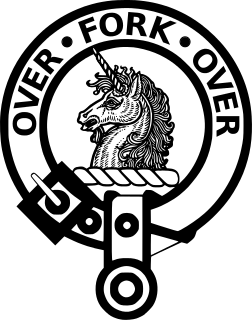
Clan Cunningham is a Scottish clan. The traditional origins of the clan are placed in the 12th century. However, the first contemporary record of the clan chiefs is in the thirteenth century. The chiefs of the Clan Cunningham supported Robert the Bruce during the Wars of Scottish Independence. In the 15th and 16th centuries the Clan Cunningham feuded with the Clan Montgomery. Historically, the chief of Clan Cunningham held the title of Earl of Glencairn. However, in modern times the chief of the clan is the Cunningham of Corsehill. On 18 December 2013, Sir John Christopher Foggo Montgomery Cunninghame, Baronet of Corsehill, was recognised by Lord Lyon as clan chief, after the chiefship had been vacant for over 200 years.

Clan Montgomery is a Lowland Scottish clan.

Mary Hay, 14th Countess of Erroll was a Scottish noblewoman and suo jure Countess of Erroll. As 18th Hereditary Lord High Constable and Knight Marischal of Scotland, she was the Senior Great Officer among the Royal Officers of Scotland and Chief of the King's Household in Scotland. She inherited these titles in 1717 on the death of her unmarried brother, Charles Hay, 13th Earl of Erroll.

Quilty, historically Killty, is a small fishing village between Milltown Malbay and Doonbeg in County Clare, Ireland. Lobster, salmon, bass, herring and mackerel are landed at Quilty, formerly known for its curing industry. The area was officially classified as part of the West Clare Gaeltacht, an Irish-speaking community, until 1956.
Éile [ˈeːle], was a medieval petty kingdom in Co.Offaly, Ireland. The historic barony of Eliogarty was the core of the kingdom.
Walter Scott, 4th Baron of Buccleuch (1549–1574) was head of the Border family of Scott and, despite his youth, played a prominent part in the turbulent politics of 16th century Scotland.
Leod Macgilleandrais is purported to have been a 14th-century Scotsman, who lived in the north-west of Scotland. He is known from clan traditions, which date to the late 17th century. According to these traditions, Leod was a follower of the Earl of Ross, and that he was an enemy of the Mackenzies of Kintail. He is said to have captured one of the early Mackenzie chiefs, and was then later killed by the slain chief's son sometime in the 14th century. His memory is preserved in the place where he is said to have been slain. According to at least one version of the tradition, Leod was survived by a son named Paul. Several historians in 19th and early 20th centuries equated this son to Paul Mactire.

Clan Cumming, also known as Clan Comyn, is a Scottish clan from the central Highlands that played a major role in the history of 13th-century Scotland and in the Wars of Scottish Independence. The Clan Comyn were the most powerful family in 13th-century Scotland, until they were defeated in civil war by their rival to the Scottish throne, Robert the Bruce.

